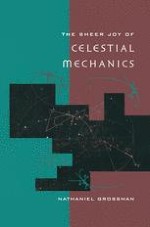1996 | Buch
Über dieses Buch
Dear Reader, Here is your book. Take it, run with it, pass it, punt it, enjoy all the many things that you can do with it, but-above all-read it. Like all textbooks, it was written to help you increase your knowledge; unlike all too many textbooks that you have bought, it will be fun to read. A preface usually tells of the author's reasons for writing the book and the author's goals for the reader, followed by a swarm of other important matters that must be attended to yet fit nowhere else in the book. I am fortunate in being able to include an insightful prepublication review that goes directly to my motivations and goals. (Look for it following this preface.) That leaves only those other important matters. In preparing the text, I consulted a number of books, chief of which included these: • S. Chandrasekhar, Ellipsoidal Figures of Equilibrium, Yale Uni versity Press, 1969. • J .M.A. Danby, Fundamentals of Celestial Mechanics, Macmil lan, 1962. Now available in a 2nd edition, 3rd printing, revised, corrected and enlarged, Willmann-Bell, 1992. • Y. Hagihara, Theories of Equilibrium Figures of a Rotating Ho mogeneous Fluid Mass, NASA, 1970. • R.A. Lyttleton, The Stability of Rotating Liquid Masses, C- ix x PREFACE bridge University Press, 1953. • C.B. Officer, Introduction to Theoretical Geophysics, Springer Verlag, 1974. • A.S. Ramsey, Newtonian Attraction, Cambridge University Press, 1949. • W.M. Smart, Celestial Mechanics, Longmans, Green, and Co, 1953.
Anzeige
